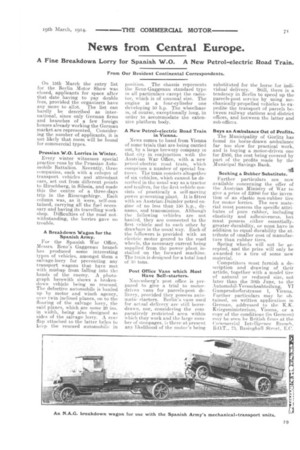News from Central Europe.
Page 21

If you've noticed an error in this article please click here to report it so we can fix it.
A Fine Breakdown Lorry for Spanish W.O. A New Petrol-electric Road Train.
From Our Resident Continental Correspondents.
On nth March the entry list for the Berlin Motor Show was closed, applicants for space after that, date having to pay double fees, provided the organizers have any more to allot. The list can hardly be described as international, since only German firms and branches of a few foreign houses already working the German market are represented. Considering the number of applicants, it is not likely that room will be found for commercial types.
Prussian W.O. Lorries in Winter.
Every winter witnesses special practice runs by the Prussian Automobile Battalion. Recently, three companies, each with a colutrin of transport vehicles and attendant cars, set out from different points to Hirschberg, in Silesia., and made this the centre of a three-days trip in the Riesengebirge. Each column was, as it were, self-contained, carrying all the fuel necessary and having its travelling work-shop. Difficulties of the road notwithstanding, the lorries gave TIO trouble.
A Breakdown Wagon for the Spanish Army.
For the Spanish War Office, Messrs. Benz's Gaggenau branch s produced some interesting types of vehicles, amongst them. a salvage-lorry for preventing any transport wagons that have met with mishap from falling into the hands of the enemy. A photograph herewith shows a brokendown vehicle being tto rescued. The defective automobile is hauled up by motor and winch agency, over twin inclined planes, on to the flooring of the salvage lorry, the said planes, which are some 20 ins. in width, being also designed as sides of the salvage lorry. A rear flap attached to the latter helps to keep the rescued automobile in
position. The chassis represents the Benz-Gaggenau standard type in all particulars except the radiator, which is of unusual size. The engine is a four-cylinder one developing 50 h.p. The wheelbase is, of course, exceptionally long, in order to accommodate the extensive platform body.
A New Petrol-electric Road Train in Vienna.
News comes to hand from Vienna of some trials that are being carried out, by a large brewery company in that city in conjunction with the Austi ian War Office, with a new petrol-electric road train, which comprises a number of special features. The train consists altogether of six vehicles, which cannot be described in the usual way as a. tractor and trailers, for the first vehicle consists of practically a self-moving power generating plant. it is fitted with an Austrian-Daimler petrol engine. of no Jess than 150 h.p., dynamo, and transmission. Although the following vehicles are not hauled, they are connected to the first vehicle and to each other by drawbars in the usual way. Each of the followers is provided with an electric motor geared to the road wheels, the necessary current being supplied from the power plant installed on the forward machine. The train is designed for a total load of 30 tons.
Post Office Vans which Must Have Sell-starters.
Nuremberg's post office is prepared to give a trial to motordriven vans for parcels-post delivery, provided they possess automatic starters. Berlin's vans used for act nal delivery are still horsedrawn, nor, considering the comparatively restricted area within whiell they work and the large n umber of stoppages. is there at present any likelihood of the motor's being
substituted for the horse for indi vidual delivery. Still, there is a tendency in Berlin to speed up the parcels-post service by using mechanically-propelled vehicles to expedite the transport of parcels between railway stations and district offices, and between the latter and sub-offices.
Buys an Ambulance Out of Profits.
The Municipality of Gorlitz has found its horse-drawn ambulance fax too slow for practical work, and is buying a motor-driven one for £800, the cost being covered by part of the profits made by the Municipal Savings Bank.
Seeking a Rubber Substitute.
Further particulars are now available concerning the offer of the Austrian Ministry of War to give a prize of £2080 for the invention or an elastic non-rubber tire for motor lorries. The new material must possess the specific attributes of pure rubber, including elasticity and adhesiveness, hut must possess either essentiallygreater durability, or must have in addition to equal durability the attribute of smaller cost of manufacture than rubber tires.
Spring wheels will not he accepted, and the prize will only be awarded to a tire of some new material.
Competitors must furnish a description and drawing of their article, together with a model tire of natural or reduced size, not later than the 30th June, to the Automobil-Tersuchsabteilung, VI Gumpendorferstrasse 1, Vienna. Further particulars may be oh mined, on written application in German, addressed to the K.K. Kriegsininisterium, Vienna, or a copy of the conditions (in German) may be seen bv British firms at the Commercial Intellipenee Branch, B.O.T., 73, Basinghall Street, E.C.


























